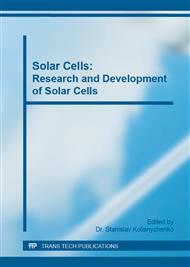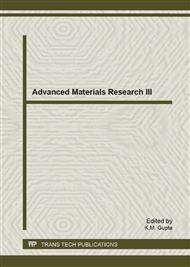p.145
p.150
p.155
p.161
p.166
p.174
p.179
p.185
p.191
SnO2 Thin Films Prepared by APCVD for Organic Solar Cells Application
Abstract:
Abstract: The amelioration of the efficiency of photovoltaic conversion in organic solar cells can be obtained by minimizing losses in reflection and absorption in the transparent electrode/active layer interface involving increased absorption efficiency in the active layer which can be achieved by the use of TCOs with special optical and electrical properties. Tin oxide SnO2 thin films have been prepared by APCVD method using the SnCl2 as a starting material. The surface morphology of the films deposited on glass substrates were investigated by scanning electron microscopy (SEM).The ellipsometry was used to determinate the refractive index for the films deposited at 480°C and the -sheet resistance was measured using the Four-Point probe. Transmittance of SnO2 films deposited on ITO was measured by UV-visible spectroscopy. SnO2 films prepared during 11 minutes present a sheet resistance of 19.57 Ωcm-2, transmittance higher than 80% and refractive index of 1.75 can be used as interfacial layer in organic solar cells application to minimize the reflectivity. The total reflectivity of SnO2/P3HT: PCBM obtained by using these films is less than 3%. SnO2 films can also be used as interfacial layers in inverted solar cells application.
Info:
Periodical:
Pages:
166-173
Citation:
Online since:
April 2013
Authors:
Keywords:
Price:
Сopyright:
© 2013 Trans Tech Publications Ltd. All Rights Reserved
Share:
Citation:



